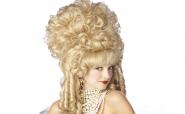Advertisement
Featured article
A clipped history of the wig
A lightning tour of wigs through the ages

In our modern day society, most wig are either covering hair loss, working in a theatre or within our judiciary system, rather than being fashion accessories. But that is exactly what they have been for thousands of years. In this article we’ll do a lightning tour of the history of wigs, to see what we’re missing out on!
All the way back in Ancient Egypt, noblemen and women clipped their hair close to their heads due to the heat, but on ceremonial occasions the ladies long and braided wigs with gold or ivory pins embedded within them. This gave them a look of grandeur while protecting their heads from the sun.
Ancient Greeks and Romans also wore wigs as a fashion accessory. Roman women had their wigs made using human hair either from India, which would be dark in colour, or in lighter shades from Northern European areas. The wigs helped disguise hair damaged by the hair dyes they used to cover grey hair, as well as enhancing their appearance.
article continuedAdvertisement
Between the fall of the Roman Empire until the 16th Century, wigs (known as “periwigs” until the word was shortened in 1675) fell out of fashion and were no longer used as sun protection. But then came Queen Elizabeth I, a trend-setter of her time with her lily-white complexion and curly red wig. It was the prematurely balding King Louis XIII of France that made wearing a wig popular amongst men, and by the reign of Louis XIV all European nobility were wearing them.
By the reign of Louis XVI the technique known as ventilating – tying knots in the hair as in rug-making – had made its appearance, and the same methods are still used today.
Wigs were not just used to improve appearance, but also due to the dirty, unsanitary living conditions of those times. It was easier to shave your head to prevent head lice and wear a wig, which was then easier to de-louse.
Since wigs were expensive to purchase and keep in good condition, it was chiefly the wealthy who wore them. By the time the 18th Century had arrived, the size and décor of wigs had becoem very elaborate. White powdered wigs with long ringlets tied back with a black bow were worn by men, while women wore styles that were modelled over a cage. The more imaginative the lady, the more elaborate the wig. This is where the English expression ‘bigwig’ comes from, meaning a person of quality, or as a reference to the British judiciary who wore wigs in court then as they do now.
Today it is only the judiciary that fly the flag for the exotic wig of high status, but I find it is a shame that wigs are not be the popular fashion accessory they once were. Why not take a leaf out of the history book and add a wig to your own wardrobe?
About the Author
Jane is a qualified beauty therapist, and owner of the 'Tooty Beauty' salon in the West Midlands.
Got something to say?
We are looking for authors! Submit an article.
Related articles
Beauty through the ages - The Renaissance
A historical period when real women were idolized
Beauty through the ages - the sophistication and minimalism of the 80s
Big hair from Dynasty to Madonna
Review: Ojon hair care system
A fantastic product that works on any type of hair
Top Stories
Makeup - less is more
Why you should avoid cosmetics overload
How to get the best haircut for your face shape
Choose the hairstyle that matches your face
Hair styling products - a guide
How to choose the right hair styling product for you
Comments
Posted on 14/09/07 00:02 by: Charlie KuchinskyI really enjoyed this article. Great job!
------------
Posted on 07/06/09 09:20 by: Louise
I'd love to know where the tale of Louis XIII wearing a wig comes from. I've seen it repeated so many times, with dates ten years apart claimed as when he started! The only contemporary reference I've seen - written by James Howell, who saw him - says that he went grey when he was about thirty and started dyeing his hair. Rather a different matter! :)
------------
Add your comment